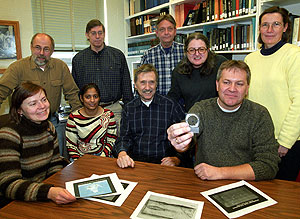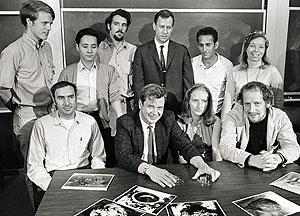It’s a short elevator ride to the fourth floor of Compton Hall — home of the Laboratory for Space Sciences in Arts & Sciences — but once there, you enter another world — one that contains samples that are literally from out of this world.
Researchers in the Laboratory for Space Sciences were some of the first to receive lunar samples from the first moon landing by Apollo 11 astronauts in 1969 and all subsequent successful Apollo missions through Apollo 17 in 1972.

And now, 34 years later, the same laboratory is once again among the first in the world to receive samples from a NASA mission — this time microscopic specks of cometary and interstellar dust particles collected on the Stardust spacecraft.
Frank J. Stadermann, Ph.D., senior research scientist in physics in Arts & Sciences and member of the Laboratory for Space Sciences, is an adviser for the Stardust mission. The Laboratory for Space Sciences is part of the departments of Physics and Earth and Planetary Sciences and the McDonnell Center for the Space Sciences, all in Arts & Sciences.
Scientists hope the Stardust mission will provide answers to fundamental questions about comets, the origin of the solar system and possibly even the origin of life itself.
Comets are believed to be the oldest, most primitive bodies in the solar system.
While most people were soundly sleeping at 3:45 a.m. Jan. 15, Stadermann was anxiously checking his home computer for news of the safe landing of Stardust‘s sample capsule.
When it touched down on the Utah salt flats after a seven-year, 2.88 billion-mile round trip, it marked the first U.S. mission since Apollo 17 to bring back solid bits of extraterrestrial material.
Two days later, Stadermann was in Houston at NASA’s Johnson Space Center, dressed from head to foot in a protective clean suit to be among the first 15 people to see the content of the sealed canister holding the mission’s much-anticipated cargo.

Stadermann said the scientists let out a hearty cheer when the canister was opened and they could see that the tennis-racket-sized collector on board the robotic Stardust spacecraft did what it was supposed to do — trap a “treasure trove” of never-before retrieved cometary material, some of which may be older than the solar system.
Stardust also captured, on the collector’s backside, interstellar dust — submicrometer-sized particles that have recently entered the solar system from interstellar space.
Launched Feb. 7, 1999, Stardust sped through the tail of comet Wild 2 at 15,000 miles per hour on Jan. 2, 2004. For 15 minutes, the spacecraft extended the honeycomb-like collector, capturing cometary dust grains in 132 ice-cube-sized cells made of aerogel, a silicon-based solid that is 99.8 percent air and resembles frozen pale-blue smoke.
Particles — each much smaller than a grain of sand — from six of the collector’s cells have been extracted and sliced up and are being disbursed to 50 labs around the world for analysis. Of those 50 labs, which are called “preliminary examination teams,” three are at WUSTL.
Working with Stadermann will be Ernst K. Zinner, Ph.D., research professor of physics and of earth and planetary sciences; Christine Floss, Ph.D., senior research scientist in earth and planetary sciences and in physics; and Kuljeet Marhas, Ph.D., postdoctoral research associate in physics.
In late February, Stadermann received his team’s first cometary material — three slices of one particle. The team is analyzing the particle’s elemental and isotopic composition in WUSTL’s state-of-the art ion probe, the NanoSIMS (SIMS is short for Secondary Ion Mass Spectrometer).
A metal frame lined with aluminum foil held the aerogel cells together. Stadermann also received three half-inch pieces of the frame to study impact craters in the aluminum foil from the particles.
“Our research group has been studying similar types of extraterrestrial material for many years, so we have some expectations of what’s in these particles,” Stadermann said. “Comets are basically cosmic refrigerators preserving material for a very long time. The Stardust samples are preserved from the early days of our solar system — 4.5 billion years ago.
“The expectation is that some of this cometary material is actually older than our solar system,” Stadermann continued.
“What we hope to find in there are the building blocks of our solar system, from which everything around us — the sun, the planets, the moon and the other components of the solar system — was originally formed.”
The NanoSIMS, which Stadermann and Zinner helped design and test, can resolve objects as small as 50 nanometers — or one thousand times smaller than the diameter of a human hair. The first NanoSIMS instrument in the world was purchased by WUSTL in 2000 for $2 million, with partial support from NASA and the National Science Foundation.
Charles Hohenberg, Ph.D., professor of physics; and Alexander Meshik, Ph.D., and Olga Pravdivtseva, Ph.D., senior research scientists in physics, will receive their own samples for analysis of noble gases by laser volatilization of particles still embedded in the aerogel. Working with them will be Jennifer Mabry, a third-year graduate student in physics.
Also receiving samples will be Brigitte Wopenka, Ph.D., senior research scientist in earth and planetary sciences, who will use a technique called “Raman microprobe spectroscopy” to characterize the inorganic composition and carbonaceous organic makeup of individual cometary dust grains.
Stadermann said researchers will be analyzing Stardust particles for years. From previous studies of interplanetary dust particles, “We know that even if you have something that is as small as these dust grains, it’s still made of hundreds of even smaller sub-components, that have their individual compositions, individual histories and individual stories to tell.”
The 50 labs will have to wait until a six-month preliminary examination period is over to release any results, but NASA scientists will present an overview of the labs’ findings at the Lunar and Planetary Science Conference March 13-17 in Houston.
“There is absolutely no question in my mind that what researchers find by analyzing these cometary dust particles will end up in fundamental textbooks about the comets and the solar system and possibly even change how we view our origins,” Stadermann said.
And just as the Apollo samples are still providing new information about the moon, the researchers on Compton’s fourth floor see the latest samples as an unending source of study.